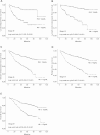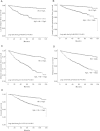Impact of preoperative anemia on relapse and survival in breast cancer patients
- PMID: 25406979
- PMCID: PMC4242544
- DOI: 10.1186/1471-2407-14-844
Impact of preoperative anemia on relapse and survival in breast cancer patients
Abstract
Background: Previous studies have shown that preoperative anemia is correlated with the prognoses of various solid tumors. This study was performed to determine the effect of preoperative anemia on relapse and survival in patients with breast cancer.
Methods: A total of 2960 patients with breast cancer who underwent surgery between 2002 and 2008 at the Sun Yat-sen University Cancer Center (Guangzhou, PR China) were evaluated in a retrospective analysis. A total of 2123 qualified patients were divided into an anemic group [hemoglobin (Hb) < 12.0 g/dL, N = 535)] and a nonanemic group (Hb ≥ 12.0 g/dL, N = 1588). The effects of anemia on local relapse-free survival (LRFS), lymph node metastasis-free survival (LNMFS), distant metastasis-free survival (DMFS), relapse-free survival (RFS), and overall survival (OS) were assessed using Kaplan-Meier analysis. Independent prognostic factors were identified in the final multivariate Cox proportional hazards regression model.
Results: Among the 2123 women who qualified for the analysis, 535 (25.2%) had a Hb level < 12.0 g/dL. The Kaplan-Meier curves showed that anemic patients had worse LRFS, LNMFS, DMFS, RFS, and OS than nonanemic patients, even in the same clinical stage of breast cancer. Cox proportional hazards regression model indicated that preoperative anemia was an independent prognostic factor of LRFS, LNMFS, DMFS, RFS, and OS for patients with breast cancer.
Conclusions: Preoperative anemia was independently associated with poor prognosis of patients with breast cancer.
Figures






References
-
- Choi YS, Yi CM, Sin JI, Ye GW, Shin IH, Lee TS. Impact of hemoglobin on survival of cervical carcinoma patients treated with concurrent chemoradiotherapy is dependent on lymph node metastasis findings by magnetic resonance imaging. Int J Gynecol Cancer. 2006;16(5):1846–1854. doi: 10.1111/j.1525-1438.2006.00666.x. - DOI - PubMed
Pre-publication history
-
- The pre-publication history for this paper can be accessed here:http://www.biomedcentral.com/1471-2407/14/844/prepub
Publication types
MeSH terms
LinkOut - more resources
Full Text Sources
Other Literature Sources
Medical
Research Materials

